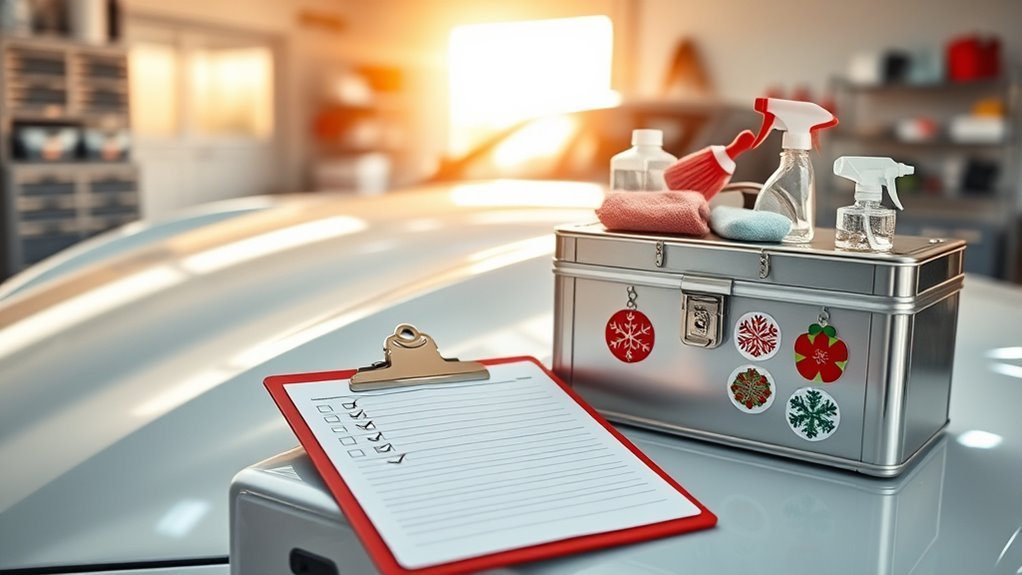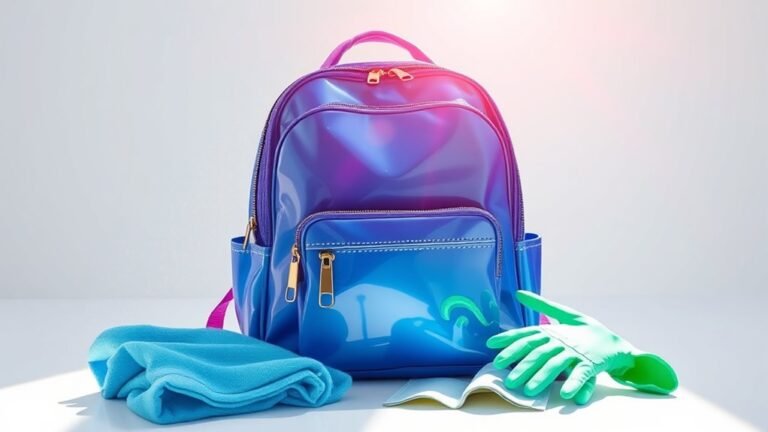Pre-Holiday Cleaning Checklist for Car
Before your holiday trip, declutter your car interior by removing trash and organizing essentials, then vacuum seats and carpets thoroughly. Clean windows, mirrors, and wipe down the dashboard with appropriate products. Check and top off engine oil, coolant, brake fluid, and washer fluid. Protect your paint with a wash and wax. Confirm emergency supplies are stocked, freshen the AC by changing the cabin filter, and test all lights and signals. For extensive tips, explore further details.
Declutter the Interior
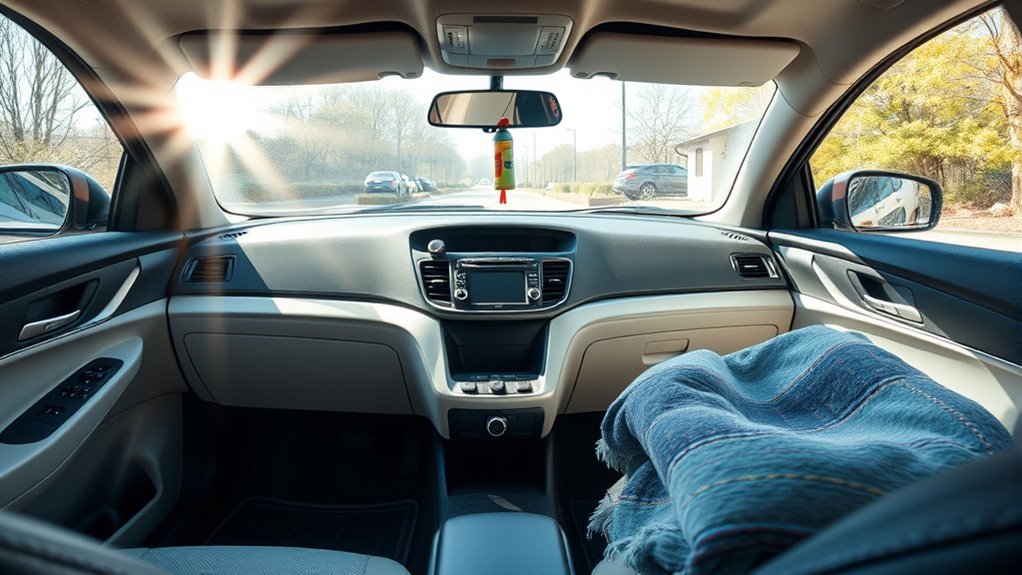
Before you begin your pre-holiday cleaning, focus on decluttering the interior by removing all unnecessary items. Start by systematically clearing out trash, loose papers, and miscellaneous objects that hinder interior organization. Use designated storage compartments efficiently to maintain order. When it comes to sentimental items, evaluate their necessity; retain only those that genuinely enhance your driving experience without creating clutter. This selective approach optimizes space, ensuring a clean, unobstructed cabin. Efficient interior organization not only improves vehicle aesthetics but also enhances safety by preventing distractions. By prioritizing minimalism and purposeful storage, you’ll create a liberating environment conducive to stress-free travel. This foundational step sets the stage for more detailed cleaning tasks, allowing you to maintain control over your vehicle’s condition throughout the holiday season.
Vacuum Seats and Carpets
Before vacuuming, you’ll want to remove any loose debris from the seats and carpets to guarantee thorough cleaning. Focus on targeting visible stains and spots with appropriate techniques to enhance the overall appearance. Use vacuum attachments designed for upholstery and tight spaces to effectively reach all areas without damaging the fabric.
Remove Loose Debris
A thorough removal of loose debris is essential to maintain your car’s interior cleanliness and prevent dirt from embedding into fabrics. Start by inspecting your seats and carpets for loose items such as crumbs, leaves, and small particles. Use a high-powered vacuum with appropriate attachments to guarantee effective debris removal, focusing on seams, crevices, and under seats where dirt accumulates. Removing loose items before deeper cleaning prevents damage to your vacuum and enhances overall efficiency. Pay attention to hard-to-reach areas and use a brush tool if necessary to dislodge stubborn debris. Consistent and precise debris removal not only preserves your car’s interior but also contributes to a fresher environment, enabling you to enjoy your vehicle with freedom and confidence during your holiday travels.
Target Stains and Spots
Once you’ve cleared away loose debris, the next step is to focus on stains and spots that can mar the appearance and hygiene of your car’s seats and carpets. Effective stain removal begins with identifying the type of stain—organic, oil-based, or synthetic—to select the appropriate cleaning agent. Gently blot fresh stains with a microfiber cloth to avoid embedding them deeper. For dried stains, apply a specialized upholstery care product designed to break down residues without damaging fabric fibers. After treating stains, vacuum the seats and carpets thoroughly to extract loosened dirt and cleaning residues, preventing re-soiling. Consistent upholstery care not only enhances your car’s interior aesthetics but also preserves material integrity, ensuring your vehicle remains a clean, inviting space that supports your freedom to travel comfortably.
Use Appropriate Vacuum Attachments
Although vacuuming might seem straightforward, using the appropriate attachments is essential for effectively cleaning your car’s seats and carpets. Different vacuum attachments are designed to target specific surfaces, ensuring thorough debris removal without damaging upholstery. For instance, a brush attachment is ideal for loosening dirt embedded in fabric seats, while a crevice tool reaches narrow gaps where dirt accumulates. Using the right vacuum attachments not only enhances cleaning efficiency but also protects the integrity of your car’s interior materials. Proper upholstery care demands gentle yet effective suction combined with suitable tools to prevent wear. By selecting and utilizing these attachments correctly, you maintain a clean, fresh environment in your vehicle, giving you the freedom to enjoy your holiday travels without the hassle of lingering dirt or debris.
Clean Windows and Mirrors
Since clear visibility is essential for safe driving, cleaning your car’s windows and mirrors should be a top priority. Start by selecting the right window cleaning techniques: use a streak-free glass cleaner and a microfiber cloth to avoid residue and scratches. Clean both the interior and exterior surfaces thoroughly, paying close attention to corners where dirt accumulates. For mirrors, apply mirror maintenance tips such as checking for cracks or chips that impair visibility, and clean them with the same glass cleaner and a soft cloth. Avoid spraying cleaner directly onto electronic mirror controls; instead, spray onto the cloth first. Regularly maintaining windows and mirrors guarantees peak clarity, helping you drive freely and safely during your holiday journey.
Wipe Down Dashboard and Controls
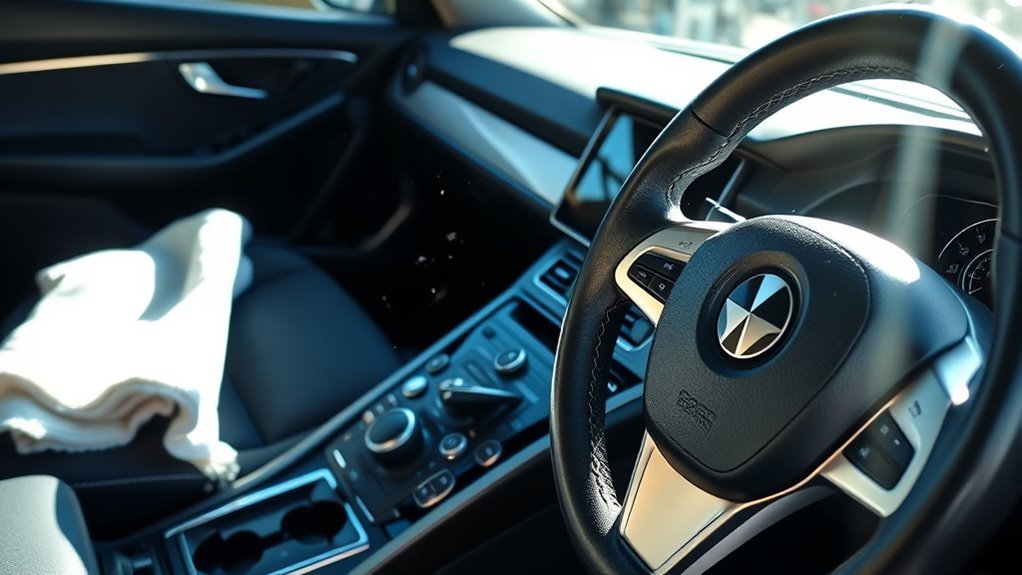
You’ll want to start by removing dust from the dashboard and controls using a microfiber cloth to avoid scratches. Choose cleaning products specifically designed for automotive interiors, such as pH-balanced sprays or wipes that won’t damage surfaces. Applying these techniques guarantees your dashboard stays clean without compromising material integrity.
Dust Removal Tips
When tackling dust removal on your car’s dashboard and controls, start by using a microfiber cloth to gently lift particles without scratching surfaces. Microfiber cloths excel in trapping dust due to their fine fibers and electrostatic properties, making them ideal for effective dusting techniques. Avoid using harsh brushes or abrasive materials that can damage delicate controls or leave residue. Work methodically, beginning with larger flat surfaces before moving to intricate areas like vents and buttons. For stubborn dust, lightly dampen the cloth with water—never saturate—to prevent moisture damage. Regularly shake out or replace microfiber cloths to maintain their dust-capturing efficiency. By mastering these precise dusting techniques, you guarantee your dashboard and controls stay clear, enhancing both your vehicle’s aesthetics and your driving freedom.
Cleaning Product Recommendations
Following proper dust removal techniques, selecting the right cleaning products guarantees your dashboard and controls receive thorough care without damage. To maintain both aesthetics and functionality, consider these essentials:
- Eco friendly cleaners: Opt for biodegradable, non-toxic formulas to protect your interior and the environment.
- Multi surface wipes: Choose alcohol-free wipes that effectively clean various materials without leaving residue.
- Soft microfiber cloths: Use these to apply cleaners gently, preventing scratches and preserving surface integrity.
- Detail brushes: Employ fine-bristled brushes to reach tight spaces around buttons and vents, ensuring exhaustive cleaning.
Check and Refill Essential Fluids
Before hitting the road for the holidays, verify all essential fluids in your car are at perfect levels to maintain performance and prevent breakdowns. Focus on fluid types such as engine oil, coolant, brake fluid, power steering fluid, and windshield washer fluid. Each plays a critical role in your vehicle’s operation and safety. Consult your owner’s manual for specific maintenance schedules to know when and how often to check or replace these fluids. Use recommended fluid grades to guarantee compatibility and peak function. Neglecting this step can lead to overheating, brake failure, or reduced steering response, limiting your freedom on the road. By systematically checking and refilling essential fluids, you safeguard your journey and keep your car running smoothly throughout your holiday travels.
Inspect Tires and Tire Pressure
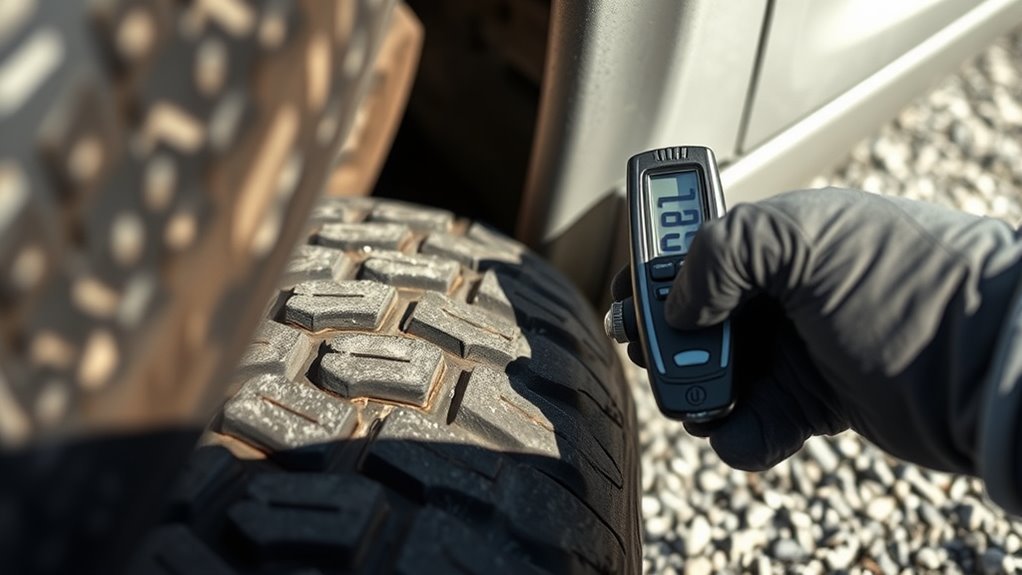
Although tire condition often goes overlooked, inspecting your tires and maintaining proper tire pressure is essential for safety and fuel efficiency during holiday travel. Here’s how to guarantee your tires are road-ready:
Ensuring your tires are properly inflated and in good condition is key for safe, efficient holiday travel.
- Use a pressure gauge to measure tire pressure when tires are cold, matching the manufacturer’s recommended PSI found in your manual or door jamb.
- Visually inspect tire tread for uneven wear or damage; tread depth should be above 2/32 inch to maintain traction.
- Check for bulges, cracks, or foreign objects embedded in the tire sidewall or tread that could compromise integrity.
- Rotate tires if needed to promote even wear, especially before a long trip.
Clean and Protect Exterior Paint
Three key steps will assure your car’s exterior paint remains protected and looks its best during holiday travel. First, thoroughly wash the surface to remove dirt, grime, and contaminants that can degrade paint protection. Use a pH-balanced car shampoo to avoid stripping existing coatings. Next, inspect for minor scratches or swirl marks, and consider using a fine polish to restore smoothness and enhance paint clarity. Finally, apply a high-quality wax application evenly across the surface. Wax acts as a sacrificial barrier, shielding your paint from UV rays, road salts, and moisture. This layer not only preserves the finish but also simplifies post-trip cleaning. By following these precise steps, you guarantee your vehicle’s exterior paint withstands environmental stressors, maintaining its aesthetic and value throughout your holiday journey.
Organize Emergency Supplies
Since unexpected situations can arise during travel, organizing your car’s emergency supplies is crucial for safety and preparedness. You’ll want a well-stocked emergency kit that includes all safety essentials to handle roadside incidents or delays. Prioritize these four key items:
- A first-aid kit with bandages, antiseptics, and necessary medications.
- Basic tools like a flashlight, jumper cables, and a multi-tool.
- Reflective warning triangles and a high-visibility vest for roadside safety.
- Non-perishable snacks and bottled water to sustain you during extended waits.
Keep everything in a compact, easy-to-access container within your vehicle. Regularly inspect and update your emergency kit to guarantee all items remain functional and unexpired. This preparation guarantees you maintain your freedom on the road with confidence and security.
Freshen Up the Air Conditioning System
When preparing your car for holiday travel, ensuring your air conditioning system is clean and efficient is essential for comfort and safety. Start by replacing the cabin air filter to improve air quality and reduce allergens. Next, inspect and clean the evaporator coil to prevent mold growth, a common source of unpleasant odors. Use an antimicrobial spray designed for automotive AC systems to aid odor elimination and inhibit bacterial buildup. Check the system’s refrigerant levels; low refrigerant can reduce cooling efficiency and worsen air quality. Run the AC for a few minutes on high after cleaning to circulate fresh air and verify system performance. Maintaining your air conditioning system not only enhances comfort but also supports a healthier, odor-free environment, giving you the freedom to enjoy your journey worry-free.
Test Lights and Signals
Before hitting the road, you’ll want to test all your car’s lights and signals to guarantee they function correctly and meet safety standards. Proper operation guarantees your freedom to drive safely and avoid traffic violations. Focus on these key checks:
- Identify the light bulb types used in your vehicle to prepare for replacements if needed.
- Activate turn signals and verify correct blinking speed and illumination on both sides.
- Test brake lights by pressing the pedal—confirm all rear bulbs illuminate simultaneously.
- Check headlights and taillights for brightness and beam alignment to ensure peak visibility.
Frequently Asked Questions
How Often Should I Schedule Professional Car Detailing?
You should schedule professional car detailing regularly, seasonally, or as needed based on your vehicle’s condition. Detailing frequency depends on your driving habits, climate, and exposure to dirt or salt. Typically, every three to six months is ideal for maintaining paint protection, interior cleanliness, and overall value. Seasonal cleaning guarantees your car withstands harsh weather changes and prevents long-term damage. Staying consistent with detailing gives you freedom to enjoy a pristine vehicle year-round.
What’S the Best Way to Remove Pet Hair From Car Seats?
To effectively remove pet hair from car seats, you’ll want to use specialized cleaning tools like a rubber bristle brush or a pet hair removal glove. These tools generate static electricity, loosening hair embedded in the fabric fibers. Vacuum the seats thoroughly afterward to capture loosened hair. For stubborn areas, use a damp microfiber cloth to gently lift remaining strands without damaging upholstery. This method guarantees efficient, thorough pet hair removal.
Can Using Air Fresheners Affect My Car’S Air Conditioning System?
You might think air fresheners improve your car’s air quality, but ironically, they can cause scent buildup that harms your air conditioning system. Over time, oils and particles from these fresheners accumulate in the vents and filters, reducing efficiency and potentially causing unpleasant odors. To maintain ideal airflow and preserve your system’s longevity, it’s best to use odor-neutralizing methods or ventilation rather than relying heavily on artificial scents.
How Do I Prevent Windshield Fogging During Winter Trips?
To prevent windshield fogging during winter trips, you should apply windshield treatments designed to repel moisture. These treatments create a hydrophobic layer that reduces condensation buildup. Additionally, use effective defogging techniques: keep your car’s ventilation system on fresh air mode, direct airflow toward the windshield, and use the air conditioner to lower humidity inside. Maintaining clean glass surfaces also helps maximize the treatments’ effectiveness, ensuring clearer visibility and safer driving freedom in cold conditions.
What Are the Signs I Need to Replace Windshield Wipers?
You’ll know it’s time to replace your windshield wipers when you notice wiper blade wear, such as cracks, splits, or frayed edges. If streaks, smears, or missed spots cause visibility issues during rain or snow, that’s a clear sign your blades aren’t performing efficiently. Ensuring clear vision is key to your freedom on the road, so don’t wait—replace worn wipers promptly to maintain safe, unobstructed driving in all conditions.
